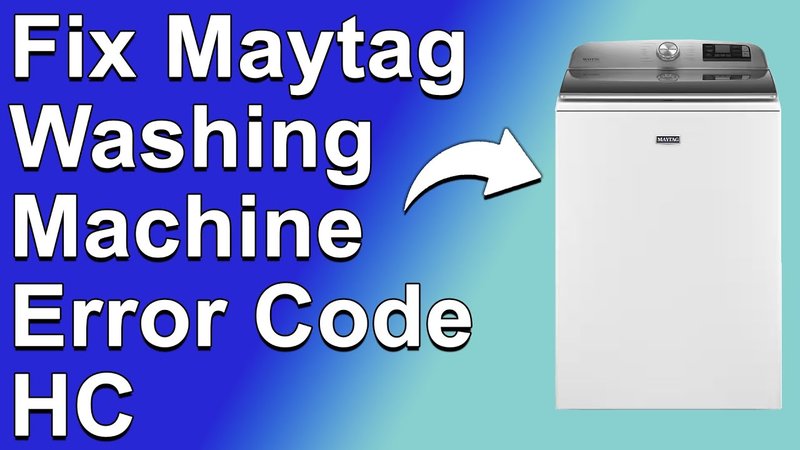
Imagine this: you’ve just loaded your Maytag washing machine with a towering pile of clothes. You’re ready for a fresh, clean start. You press the power button, and suddenly, your washing machine flashes an ominous “F1” error code. It’s normal to feel a wave of confusion. What does this mean? Should you be worried? Don’t stress; you’re not alone in facing this common hiccup with Maytag washers.
Understanding the cryptic error codes of washing machines can feel like deciphering a foreign language. But here’s the good news: you don’t need to be a tech guru to figure this out. Error code F1 on a Maytag washing machine is a common issue that indicates a problem with the machine’s primary control board. Think of it like the brain of your washer, which manages all those critical tasks like water levels and spin cycles. If something goes awry, it sends out an F1 code as a distress signal. Let’s dive deeper into what could be causing this and how you can tackle it.
Understanding the Control Board Issue
The control board is essentially the central hub of your washing machine, much like the conductor of an orchestra. It coordinates every move, from filling the drum with water to the final spin cycle. When the F1 error code appears, it’s often a sign that the control board is struggling to communicate properly with the rest of the machine. This could be due to a range of issues, such as electrical problems, or even moisture damage. You might be wondering how something so small can cause such a big fuss, but the control board is crucial for the machine’s overall operation.
Think of the control board as a kind of computer that runs specific programs. Just like a computer with a virus, if it starts malfunctioning, everything else goes haywire. Sometimes, the control board can receive false signals or become overloaded, and this results in the F1 code. In simple terms, the control board is saying, “I need help!”
So, how can you fix this? One potential solution is resetting the machine. Much like rebooting a computer, unplugging the washer for a few minutes can sometimes clear minor glitches. However, if the error persists, it might require a more thorough inspection by a professional to determine if the control board needs repair or replacement.
Electrical and Wiring Concerns
Another potential culprit for the F1 error code is electrical issues within the washing machine. Imagine the electrical system in your washer as a network of roads. If there’s a roadblock or a detour, nothing flows smoothly. Sometimes, loose connections or faulty wiring can disrupt the flow of electricity to the control board, causing it to send out an error message.
Electricity is the lifeblood of any appliance, and without a steady supply, you’re bound to face trouble. A common problem could be worn-out wiring or connections that have loosened over time. This is especially true in older machines or those that have been frequently moved around.
To address this, checking the wiring and connections can reveal any obvious issues like frayed wires or loose plugs. If you’re not comfortable with this, it might be a good idea to call in an expert. Regular maintenance and keeping your machine in a stable, moisture-free environment can help prevent such issues.
Water Level and Sensor Malfunctions
Yet another reason for the F1 error could be problems with the water level sensor. This sensor tells the control board how much water is in the drum. Think of it like a scale that weighs the amount of water and reports back to the brain of the machine. If the sensor is faulty or clogged, it might send inaccurate readings, prompting the F1 alert.
To visualize this, imagine trying to bake a cake and your kitchen scale keeps giving you different measurements for the same amount of flour. You’d end up with a mess, right? Similarly, the washing machine can’t function properly if it doesn’t know how much water it’s dealing with.
In such cases, cleaning or replacing the sensor might solve the problem. Regularly checking for sediment build-up or debris in the water sensor can help maintain its accuracy. A simple clean-up might do the trick, but if not, consulting a repair service is advisable.
Steps to Prevent Future F1 Errors
Now that we’ve wrestled with the common causes behind the F1 code, let’s talk prevention. Regular maintenance is key to keeping your washing machine happy and functioning properly. Much like getting your car serviced, periodic checks can save you from unexpected breakdowns.
First, ensure your washing machine is placed in a suitable environment, free from excessive moisture or temperature swings. Such conditions can wreak havoc on electrical components and sensors. Second, consider scheduling a professional service every year to check wiring, sensors, and connections. This proactive approach can extend the lifespan of your washing machine.
Finally, if you notice any unusual behavior before an F1 error appears, address it sooner rather than later. Strange noises, unexpected stops, or water level issues can be early signs that something’s amiss. By staying alert and responsive, you can prevent minor issues from escalating into major problems.
Remember, while technology makes our lives easier, it requires a little care in return. With some attention and upkeep, your Maytag washing machine will continue to serve you well, minus the interruptions of unexpected error codes. Happy washing!
